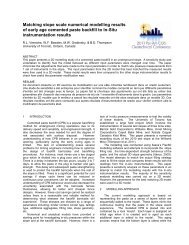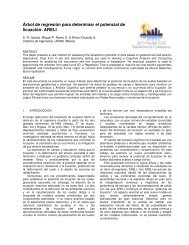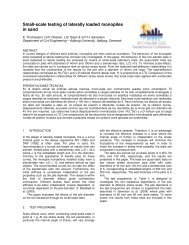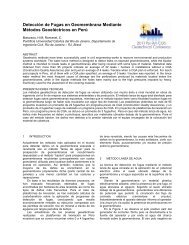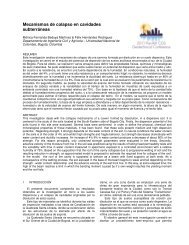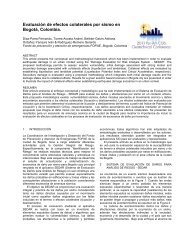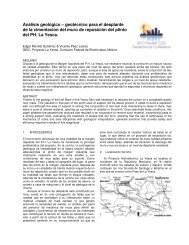The Working Classification of Landslides: material matters
The Working Classification of Landslides: material matters
The Working Classification of Landslides: material matters
Create successful ePaper yourself
Turn your PDF publications into a flip-book with our unique Google optimized e-Paper software.
the rupture surface may be enlarging, continually addingto the volume <strong>of</strong> displacing <strong>material</strong>. If the rupturesurface is extending in the direction opposite to themovement <strong>of</strong> the displaced <strong>material</strong>, the landslide is saidto be retrogressing. If the rupture surface is extending inthe direction <strong>of</strong> movement the landslide is advancing. Ifthe rupture surface is extending at one or both lateralmargins, the landslide is widening. Confined movementshave a scarp but no rupture surface visible in the foot <strong>of</strong>the displaced mass; displacements in the head <strong>of</strong> thedisplaced mass are taken up by compression and slightbulging in the foot <strong>of</strong> the mass. If the rupture surface <strong>of</strong>the landslide is enlarging in two or more directions,Varnes (1978, p. 23) suggested the term progressive forthe landslide while noting this term had also been usedfor both advancing and retrogressing landslides. Thisterm is also current for describing the process,progressive failure, by which the rupture surface in someslides extends. <strong>The</strong> possibility <strong>of</strong> confusion seemssufficient now to abandon "progressive" in favour <strong>of</strong>describing the landslide as enlarging.To complete the possibilities, terms are needed forlandslides in which the volume <strong>of</strong> displacing <strong>material</strong> canbe seen to be reducing with time and for those landslideswhere no trend is obvious. Movements such as rotationalslides and topples may stop naturally after substantialdisplacements because the movements themselvesreduce the gravitational forces on the displaced masses.Alternatively, rock masses may be dilated by movementsthat rapidly increase the volumes <strong>of</strong> cracks in the massesand cause decreases in fluid pore pressures within thesecracks. However, to conclude that the displacing mass isstabilizing because its volume is decreasing may bepremature; the activity <strong>of</strong> rotational slides caused byerosion at the toe <strong>of</strong> slopes in cohesive soils is <strong>of</strong>tencyclic. <strong>The</strong> term, diminishing, for a landslide whosedisplacing <strong>material</strong> is decreasing in volume seems free <strong>of</strong>undesired implications. <strong>Landslides</strong> whose displaced<strong>material</strong>s continue to move but whose rupture surfacesshow no visible changes can be simply described asmoving.movements. WP/WLI (1993 a, b) adopted the convention<strong>of</strong> treating the higher <strong>of</strong> the two movements as the firstmovement and the lower <strong>of</strong> the two movements as thesecond movement in the absence <strong>of</strong> more definiteinformation.A multiple landslide shows repeated movements <strong>of</strong>the same type, <strong>of</strong>ten following the enlargement <strong>of</strong> therupture surface. <strong>The</strong> newly displaced masses are incontact with previously displaced masses and <strong>of</strong>tenshare a rupture surface with them. In a retrogressive,multiple, rotational slide, two or more blocks have eachmoved on curved rupture surfaces tangential to acommon generally deep rupture surface.A successive movement is identical in type to anearlier movement but in contrast to a multiple movementit does not share displaced <strong>material</strong> or a rupture surfacewith it.Single landslides consist <strong>of</strong> a single movement <strong>of</strong>displaced <strong>material</strong> <strong>of</strong>ten as an unbroken block. <strong>The</strong>ycontrast with the other styles <strong>of</strong> movement which requiredisruption <strong>of</strong> the displaced mass or independentmovements <strong>of</strong> portions <strong>of</strong> the mass.2.3 Style <strong>of</strong> activity<strong>The</strong> way in which different movements contribute to thelandslide, the style <strong>of</strong> the landslide activity, can bedescribed by terms from Varnes (1978, p. 23). <strong>The</strong>re,complex landslides are defined as exhibiting at least twotypes <strong>of</strong> movements. We propose to limit the term hereto movements in which the types are in sequence; atopple in which some <strong>of</strong> the displaced masssubsequently slid is a complex rock-topple rock-slide. Notall the toppled mass slid but no significant part <strong>of</strong> thedisplaced mass slid without first toppling. Notice thatsome <strong>of</strong> the displaced mass may be still toppling whileother parts are sliding.We can use a former synonym <strong>of</strong> complex,composite, to describe landslides in which different types<strong>of</strong> movement occur in different areas <strong>of</strong> the displacedmass, sometimes simultaneously. <strong>The</strong>se different areas<strong>of</strong> the displaced mass show different sequences <strong>of</strong>Figure 1. Successive stages in the cyclic behaviour <strong>of</strong>London Clay cliffs subjected to strong toe erosion(adapted from Hutchinson 1973
3 RATE OF MOVEMENT<strong>The</strong> IUGS <strong>Working</strong> Group (1995) modified the rate <strong>of</strong>movement scale given in Varnes (1978, Figure 2:1 u).<strong>The</strong> seven divisions <strong>of</strong> the scale are now adjusted toincrease in multiples <strong>of</strong> 100 by slightly increasing theuppermost limit <strong>of</strong> the scale and decreasing the lowestlimit <strong>of</strong> the scale. <strong>The</strong>se two limits span ten orders <strong>of</strong>magnitude (from 0.5x10-6 to 5x103 mm/sec).An important division between very rapid andextremely rapid movement, approximates the speed <strong>of</strong> aperson running (5 m/sec.). Another important boundaryis between the slow and very slow classes (1.6 m/year),below which some structures on the landslide areundamaged. Terzaghi (1950, p. 84) identified slopemovements "proceeding at an imperceptible rate" as"creep". <strong>The</strong> many uses <strong>of</strong> the term "creep" have beendiscussed by Varnes (1978, p. 17), the term is now tooambiguous for general use and should be replaced by theappropriate modifiers, either very slow or extremely slow,applied to the other landslide descriptors.4 WATER CONTENTVarnes (1978) suggested four terms derived from simpleobservations <strong>of</strong> the water content <strong>of</strong> the displaced<strong>material</strong>: 1) Dry, no moisture, 2) Moist, contains somewater but no free water, the <strong>material</strong> may behave as aplastic solid but does not flow, 3) Wet, contains enoughwater to behave in part as a liquid, has water flowingfrom it, or supports significant bodies <strong>of</strong> standing water,and 4) Very wet, contains enough water to flow as aliquid under low gradient. A fifth term, 5) Frozen, wassuggested by Cruden and Couture (2010) for use inpermafrost terrainsAs most slope instabilities in permafrost terrain resultfrom or are directly related to the phase change <strong>of</strong> water,it may be worth introducing the term ‘thawed’, whichbetter expresses the state <strong>of</strong> the ground and its watercontent while landsliding. In the ‘thawed’ state, or in thetransition from frozen to ‘thawed’, such terrain providessignificant amounts <strong>of</strong> water in a liquid phase thatcontribute to slope instability (Figure 2).<strong>The</strong>se terms should be used to describe the massesdisplaced by the landslide. <strong>The</strong> water content <strong>of</strong> thedisplaced masses may give useful guidance forassumptions about the water content <strong>of</strong> the displacing<strong>material</strong>s while the <strong>material</strong>s were displacing. Howeversoil or rock masses may drain quickly after displacementand individual rock or soil masses may have watercontents which differ considerably from the averagewater content <strong>of</strong> the displacing <strong>material</strong>. In somefine-grained soils, the boundaries between the terms maycorrespond approximately with Atterberg Limits, theShrinkage, Plastic and Liquid Limits separating dry,moist, wet and very wet soils respectively.<strong>The</strong> <strong>Working</strong> Party followed Varnes (1978) in describing<strong>material</strong>s in landslides as either rock, a hard or firmmass that was intact and in its natural place before theinitiation <strong>of</strong> movement, or soil, an aggregate <strong>of</strong> solidparticles generally <strong>of</strong> minerals and rocks which has eitherbeen transported or formed by the weathering <strong>of</strong> rock inplace. Gases or liquids filling the pores <strong>of</strong> the soil formpart <strong>of</strong> the soil.Soil is divided into debris and earth. Debris contains asignificant proportion <strong>of</strong> coarse <strong>material</strong>; 20 to 80 percent<strong>of</strong> the particles are larger than 2 mm, the remainder areless than 2 mm. Earth describes <strong>material</strong> in which80 percent or more <strong>of</strong> the particles are smaller than2 mm; it includes a range <strong>of</strong> <strong>material</strong>s from non-plasticsand to highly plastic clay.In the absence <strong>of</strong> international standards, the<strong>Working</strong> Party was unable to progress beyond thissimple division. With the adoption <strong>of</strong> an InternationalStandard (ISO 14688-1) for the identification anddescription <strong>of</strong> soil, some further observations may beuseful during the reconnaissance <strong>of</strong> the landslide. Flowcharts have been developed for the identification anddescription <strong>of</strong> soils (Figure 3; Norbury 2010, Figures 4.1and 4.3).a)5 MATERIAL
a)Is the <strong>material</strong> cemented orlithified and <strong>of</strong> high strength?YES = ROCKNO = SOILIs the <strong>material</strong> laid by naturalprocesses?b)NO = MADE GROUNDYES = NATURAL SOILFigure 2. a) Retrogressive thaw flows are retrogressive,complex, slow, ‘thawed’, moist, earth slide-wet earthflows in the <strong>Working</strong> <strong>Classification</strong> (GSC-ESS Photo No.2007-51; Photographer: R. Couture). b) A bimodal flowor retrogressive thaw flow is a retrogressive, complex,moderate, ‘thawed’ earth slide-very wet, earth flow in the<strong>Working</strong> <strong>Classification</strong> (GSC-ESS No. Photo 2007-59;Photographer: R. Couture).<strong>The</strong>y first distinguish <strong>material</strong>s, made ground, organicsoil, and volcanic soil by the way in which they areformed (Figure 3a). <strong>The</strong>se <strong>material</strong>s have been thesubjects <strong>of</strong> specialized studies by construction,transportation, and forestry engineers and byvolcanologists among others (Keegan 2007; MacFarlane1969; Francis 1993) Specialized terminologies exist fordescribing particular types <strong>of</strong> landslides that occur inthese <strong>material</strong>s. <strong>The</strong> merging <strong>of</strong> these terminologies withthe <strong>Working</strong> <strong>Classification</strong> awaits further study.It is interesting however to ask whether the grain sizedescription <strong>of</strong> <strong>material</strong>s advocated in the remaining part<strong>of</strong> the flow diagram might also be usefully applied tothese <strong>material</strong>s (Figure 3b). Keegan et al. (2007)suggested this possibility.<strong>The</strong> International Standard (ISO 14688-1) dividedsoils into cohesive (fine) and cohesionless (coarse) soils.Fine soil can be conveniently divided into silts and claysby the qualitative observations <strong>of</strong> plasticity, dilatancy andother properties.b)Are most particles >2 mm?YESGRAVELNONODoes soil stick together whenwet and remould?YESDoes soil display lowplasticity, dilatancy. Silkytouch, disintegrate in waterand dry quicklyYESNOSAND SILT CLAYFigure 3. Flow charts for the identification <strong>of</strong> soils(adapted from Norbury 2010, Figs. 4.1 and 4.3).So, when a uniform soil is displaced in an earthlandslide, it should be possible to readily classify the<strong>material</strong> as debris, sand, silt, or clay by inspection <strong>of</strong>either the margins or main scarp <strong>of</strong> the landslide or <strong>of</strong>undeformed <strong>material</strong> amid the landslide deposits (Figure4). As examples <strong>of</strong> this practice, Varnes (1978, Figures2:24, 2:25) and Hungr et al. (2001, Figures 5, 6) haveillustrated both sand and silt flows.6 TYPES OF MOVEMENTIn this section, the five kinematically-distinct types <strong>of</strong>landslides are described in the sequence, fall, topple,slide, spread and flow.A fall starts with the detachment <strong>of</strong> soil or rock from asteep slope along a surface on which little or no sheardisplacement takes place. <strong>The</strong> <strong>material</strong> then descendslargely through the air by falling, saltation or rolling.Movement is very rapid to extremely rapid. Except whenthe displaced mass has been undercut, falling will bepreceded by small sliding or toppling movements which
separate the displacing <strong>material</strong> from the undisturbedmass. Under-cutting typically occurs in cohesive soils orrocks at the toe <strong>of</strong> cliffs undergoing wave attack or in theeroding banks <strong>of</strong> rivers.A topple is the forward rotation out <strong>of</strong> the slope <strong>of</strong> amass <strong>of</strong> soil or rock about a point or axis below thecentre <strong>of</strong> gravity <strong>of</strong> the displaced mass. Toppling issometimes driven by gravity exerted through <strong>material</strong>upslope <strong>of</strong> the displaced mass, and sometimes throughwater or ice in cracks in the mass. Topples may lead t<strong>of</strong>alls or slides <strong>of</strong> the displaced mass depending on thegeometry <strong>of</strong> the moving mass, <strong>of</strong> the surface <strong>of</strong>separation and the orientation and extent <strong>of</strong> thekinematically-active discontinuities. Topples range fromextremely slow to extremely rapid, sometimesaccelerating throughout the movement.A slide is a downslope movement <strong>of</strong> a rock massoccurring dominantly on surfaces <strong>of</strong> rupture or relativelythin zones <strong>of</strong> intense shear strain. Movement is usuallyprogressive; it does not initially occur simultaneouslyover the whole <strong>of</strong> what eventually becomes the surface <strong>of</strong>rupture, it propagates from an area <strong>of</strong> local failure. Oftenthe first signs <strong>of</strong> ground movement are cracks in theoriginal ground surface along which the main scarp <strong>of</strong> theslide will form. <strong>The</strong> displaced mass may slide beyond thetoe <strong>of</strong> the surface <strong>of</strong> rupture covering the original groundsurface <strong>of</strong> the slope which then becomes a surface <strong>of</strong>separation.We define a spread as an extension <strong>of</strong> a cohesive soilor rock mass combined with a general subsidence <strong>of</strong> thefractured mass <strong>of</strong> cohesive <strong>material</strong> into s<strong>of</strong>ter underlying<strong>material</strong>. <strong>The</strong> rupture surface is not a surface <strong>of</strong> intenseshear. Spreads may result from liquefaction or flow (andextrusion) <strong>of</strong> the s<strong>of</strong>ter <strong>material</strong>. Varnes (1978)distinguished spreads, typical <strong>of</strong> rock, which extendedwithout forming an identifiable rupture surface frommovements in cohesive soils overlying liquefied <strong>material</strong>sor <strong>material</strong>s which are flowing plastically. <strong>The</strong> cohesive<strong>material</strong>s may also subside, translate, rotate, disintegrateor liquefy and flow. Clearly these movements arecomplex but they are sufficiently common in certain<strong>material</strong>s and geological situations that a separate type<strong>of</strong> movement is worth recognizing.A flow is a spatially continuous movement in whichsurfaces <strong>of</strong> shear are short-lived, closely spaced and notusually preserved. <strong>The</strong> distribution <strong>of</strong> velocities in thedisplacing mass resembles that in a viscous liquid. <strong>The</strong>lower boundary <strong>of</strong> the displaced mass may be a surfacealong which appreciable differential movement has takenplace or a thick zone <strong>of</strong> distributed shear. <strong>The</strong>re is then agradation from slides to flows depending on the watercontent, mobility and evolution <strong>of</strong> the movement. Debrisslides may become extremely rapid debris flows, debrisavalanches, as the displaced <strong>material</strong> loses cohesion,gains water or encounters steeper slopes.a)b)Figure 4. a) May 10th, 2010 St-Jude (QC) clay spread inChamplain Sea cohesive, fine sediments (Photo RNCan#2010-152; Photographer: R. Couture). b) 1996 Lemieux(ON) silt and clay flow in fine Champlain Sea deposits(Photo RNCan # 2002-690; Photographer: G.R. Brooks).7 SUMMARYAn initial reconnaissance <strong>of</strong> a landslide might beexpected to describe the activity and the <strong>material</strong>sdisplaced in this particular type <strong>of</strong> landslide. This formatlends itself to the creation <strong>of</strong> simple databases suited tomuch <strong>of</strong> the database management s<strong>of</strong>tware nowavailable. <strong>The</strong> information collected can be comparedwith summaries <strong>of</strong> other landslides (WP/WLI 1991) andused to guide further investigations and mitigativemeasures. Further investigation increases the precision<strong>of</strong> estimates <strong>of</strong> the dimensions and confidence in thedescriptions <strong>of</strong> activity and <strong>material</strong> and in thehypotheses about causes <strong>of</strong> the movement. <strong>The</strong> newinformation may finally be added to the database toinfluence the analysis <strong>of</strong> further landslides. <strong>The</strong>sedatabases can be expected to form the foundations <strong>of</strong>systems for landslide mitigation and landslide riskassessment (Cruden & Fell 1997). <strong>The</strong> <strong>Working</strong><strong>Classification</strong> <strong>of</strong> <strong>Landslides</strong> would benefit from theadditional States <strong>of</strong> Activity, preparatory, marginal and
epaired. Frozen as a descriptor <strong>of</strong> water content wouldallow the characterization <strong>of</strong> landslides in permafrost.According to an International Standard, earth may bedivided into sand, silt or clay by simple fieldobservations. More study may allow landslides in madeground and in organic and volcanic soils to beincorporated in the <strong>Working</strong> <strong>Classification</strong>.ACKNOWLEDGEMENTS<strong>The</strong> authors would like to thank Anne-Marie Leblanc(Geological Survey <strong>of</strong> Canada) for the review <strong>of</strong> themanuscript and Alain Grignon (Geological Survey <strong>of</strong>Canada) for improvements to Figure 3. This paper is anESS Contribution No. 2011041.REFERENCESCruden, D.M. & Fell, R. (eds) 1997. Landslide RiskAssessment. Balkema, Rotterdam, 370 pages.Cruden, D.M., Couture, R., 2010 More comprehensivecharacterization <strong>of</strong> landslides : Review & additionsProceedings, 11th IAEG Congress, Auckland, NewZealand, pp 1033-1042Cruden, D.M. & Varnes, D.J. 1996. Landslide Types andProcesses. In Turner, A.K., Schuster, R.L. (eds),<strong>Landslides</strong>: Investigation and Mitigation,Transportation Research Board, Special Report, 247:36-75.Francis, P. 1993. Volcanoes: A Planetary Perspective,Clarendon Press, Oxford, 443 pages.Hungr, O., Evans, S.G., Bovis, M.J., Hutchinson, J.N.,2001, A review <strong>of</strong> the classification <strong>of</strong> landslides <strong>of</strong>the flow type, Environmental & EngineeringGeoscience, 7, 221-238Hutchinson, J.N. 1973. <strong>The</strong> response <strong>of</strong> London ClayCliffs to differing rates <strong>of</strong> toe erosion. GeologiaApplicata e idrogeologica, 8: 221-239.International Organization for Standardization, 2002,Geotechnical investigation, 2002, Geotechnicalinvestigation and testing – Identification andclassification <strong>of</strong> soil – Part 1: Identification anddescription, ISO 14688-1 12 p.International Union <strong>of</strong> Geological Sciences <strong>Working</strong>Group on <strong>Landslides</strong> 1995. A suggested method fordescribing the rate <strong>of</strong> movement <strong>of</strong> a landslide.Bulletin International Association <strong>of</strong> EngineeringGeology, 52: 75-78.Keegan, T. 2007. Methodology for Risk Analysis <strong>of</strong>Railway Ground Hazards. Ph.D. thesis, University <strong>of</strong>Alberta, Edmonton, 446 pages.Keegan,T., Cruden,D.M., Martin,C.D., Morgenstern,N.,Ruel,M. & Pritchard,M. 2007. A railway groundhazard risk management methodology overview.Proceedings <strong>of</strong> the 60th Canadian geotechnicalconference, Ottawa, 21-24 October, 2007: 8 pages .MacFarlane, I.C. 1969. Muskeg Engineering Handbook.University <strong>of</strong> Toronto press, Toronto, 297 pages.Norbury D. 2010. Soil and Rock Description inEngineering Practice. CRC Press 283 pages.Terzaghi, K. 1950. Mechanism <strong>of</strong> landslides. In S. Paige(ed.), Application <strong>of</strong> Geology to Engineering Practice,Geological Society <strong>of</strong> America, New York: 83-123.Turner, A.K. & Schuster, R.L. (eds) 1996. <strong>Landslides</strong>:Investigation and Mitigation. Transportation ResearchBoard, Special Report 247.Varnes, D.J. 1978. Slope movement types andprocesses. In R.L. Schuster and R.J. Krizek (eds),<strong>Landslides</strong>: Analysis and Control. TransportationResearch Board, National Academy <strong>of</strong> Sciences,Washington, D.C.WP/WLI (International Geotechnical Societies' UNESCO<strong>Working</strong> Party on World Landslide Inventory) 1990.A suggested method for reporting a landslide. BulletinInternational Association <strong>of</strong> Engineering Geology,41: 5-12.WP/WLI (International Geotechnical Societies' UNESCO<strong>Working</strong> Party on World Landslide Inventory) 1991.A suggested method for a landslide summary. BulletinInternational Association <strong>of</strong> Engineering Geology,43: 101-110.WP/WLI (International Geotechnical Societies' UNESCO<strong>Working</strong> Party on World Landslide Inventory) 1993a.A suggested method for describing the activity <strong>of</strong> alandslide, Bulletin International Association <strong>of</strong>Engineering Geology, 47: 53-57.WP/WLI (International Geotechnical Societies' UNESCO<strong>Working</strong> Party on World Landslide Inventory) 1993b.Multilingual Landslide Glossary. Bitech Publishers,Richmond, British Columbia, 59 pages.WP/WLI (International Geotechnical Societies' UNESCO<strong>Working</strong> Party on World Landslide Inventory) 1994.A suggested method for describing the causes <strong>of</strong> alandslide. Bulletin International Association <strong>of</strong>Engineering Geology, 50: 71-74.




